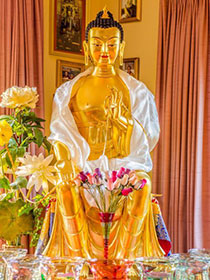- Home
- FPMT Homepage
Foundation for the Preservation of the Mahayana Tradition
The FPMT is an organization devoted to preserving and spreading Mahayana Buddhism worldwide by creating opportunities to listen, reflect, meditate, practice and actualize the unmistaken teachings of the Buddha and based on that experience spreading the Dharma to sentient beings. We provide integrated education through which people’s minds and hearts can be transformed into their highest potential for the benefit of others, inspired by an attitude of universal responsibility and service. We are committed to creating harmonious environments and helping all beings develop their full potential of infinite wisdom and compassion. Our organization is based on the Buddhist tradition of Lama Tsongkhapa of Tibet as taught to us by our founders Lama Thubten Yeshe and Lama Thubten Zopa Rinpoche.
- Willkommen
Die Stiftung zur Erhaltung der Mahayana Tradition (FPMT) ist eine Organisation, die sich weltweit für die Erhaltung und Verbreitung des Mahayana-Buddhismus einsetzt, indem sie Möglichkeiten schafft, den makellosen Lehren des Buddha zuzuhören, über sie zur reflektieren und zu meditieren und auf der Grundlage dieser Erfahrung das Dharma unter den Lebewesen zu verbreiten.
Wir bieten integrierte Schulungswege an, durch denen der Geist und das Herz der Menschen in ihr höchstes Potential verwandelt werden zum Wohl der anderen – inspiriert durch eine Haltung der universellen Verantwortung und dem Wunsch zu dienen. Wir haben uns verpflichtet, harmonische Umgebungen zu schaffen und allen Wesen zu helfen, ihr volles Potenzial unendlicher Weisheit und grenzenlosen Mitgefühls zu verwirklichen.
Unsere Organisation basiert auf der buddhistischen Tradition von Lama Tsongkhapa von Tibet, so wie sie uns von unseren Gründern Lama Thubten Yeshe und Lama Thubten Zopa Rinpoche gelehrt wird.
- Bienvenidos
La Fundación para la preservación de la tradición Mahayana (FPMT) es una organización que se dedica a preservar y difundir el budismo Mahayana en todo el mundo, creando oportunidades para escuchar, reflexionar, meditar, practicar y actualizar las enseñanzas inconfundibles de Buda y en base a esa experiencia difundir el Dharma a los seres.
Proporcionamos una educación integrada a través de la cual las mentes y los corazones de las personas se pueden transformar en su mayor potencial para el beneficio de los demás, inspirados por una actitud de responsabilidad y servicio universales. Estamos comprometidos a crear ambientes armoniosos y ayudar a todos los seres a desarrollar todo su potencial de infinita sabiduría y compasión.
Nuestra organización se basa en la tradición budista de Lama Tsongkhapa del Tíbet como nos lo enseñaron nuestros fundadores Lama Thubten Yeshe y Lama Zopa Rinpoche.
A continuación puede ver una lista de los centros y sus páginas web en su lengua preferida.
- Bienvenue
L’organisation de la FPMT a pour vocation la préservation et la diffusion du bouddhisme du mahayana dans le monde entier. Elle offre l’opportunité d’écouter, de réfléchir, de méditer, de pratiquer et de réaliser les enseignements excellents du Bouddha, pour ensuite transmettre le Dharma à tous les êtres. Nous proposons une formation intégrée grâce à laquelle le cœur et l’esprit de chacun peuvent accomplir leur potentiel le plus élevé pour le bien d’autrui, inspirés par le sens du service et une responsabilité universelle. Nous nous engageons à créer un environnement harmonieux et à aider tous les êtres à épanouir leur potentiel illimité de compassion et de sagesse. Notre organisation s’appuie sur la tradition guéloukpa de Lama Tsongkhapa du Tibet, telle qu’elle a été enseignée par nos fondateurs Lama Thoubtèn Yéshé et Lama Zopa Rinpoché.
Visitez le site de notre Editions Mahayana pour les traductions, conseils et nouvelles du Bureau international en français.
Voici une liste de centres et de leurs sites dans votre langue préférée
- Benvenuto
L’FPMT è un organizzazione il cui scopo è preservare e diffondere il Buddhismo Mahayana nel mondo, creando occasioni di ascolto, riflessione, meditazione e pratica dei perfetti insegnamenti del Buddha, al fine di attualizzare e diffondere il Dharma fra tutti gli esseri senzienti.
Offriamo un’educazione integrata, che può trasformare la mente e i cuori delle persone nel loro massimo potenziale, per il beneficio di tutti gli esseri, ispirati da un’attitudine di responsabilità universale e di servizio.
Il nostro obiettivo è quello di creare contesti armoniosi e aiutare tutti gli esseri a sviluppare in modo completo le proprie potenzialità di infinita saggezza e compassione.
La nostra organizzazione si basa sulla tradizione buddhista di Lama Tsongkhapa del Tibet, così come ci è stata insegnata dai nostri fondatori Lama Thubten Yeshe e Lama Zopa Rinpoche.
Di seguito potete trovare un elenco dei centri e dei loro siti nella lingua da voi prescelta.
- 欢迎 / 歡迎
简体中文
“护持大乘法脉基金会”( 英文简称:FPMT。全名:Foundation for the Preservation of the Mahayana Tradition) 是一个致力于护持和弘扬大乘佛法的国际佛教组织。我们提供听闻,思维,禅修,修行和实证佛陀无误教法的机会,以便让一切众生都能够享受佛法的指引和滋润。
我们全力创造和谐融洽的环境, 为人们提供解行并重的完整佛法教育,以便启发内在的环宇悲心及责任心,并开发内心所蕴藏的巨大潜能 — 无限的智慧与悲心 — 以便利益和服务一切有情。
FPMT的创办人是图腾耶喜喇嘛和喇嘛梭巴仁波切。我们所修习的是由两位上师所教导的,西藏喀巴大师的佛法传承。
繁體中文
護持大乘法脈基金會”( 英文簡稱:FPMT。全名:Found
ation for the Preservation of the Mahayana Tradition ) 是一個致力於護持和弘揚大乘佛法的國際佛教組織。我們提供聽聞, 思維,禪修,修行和實證佛陀無誤教法的機會,以便讓一切眾生都能 夠享受佛法的指引和滋潤。 我們全力創造和諧融洽的環境,
為人們提供解行並重的完整佛法教育,以便啟發內在的環宇悲心及責 任心,並開發內心所蘊藏的巨大潛能 — 無限的智慧與悲心 – – 以便利益和服務一切有情。 FPMT的創辦人是圖騰耶喜喇嘛和喇嘛梭巴仁波切。
我們所修習的是由兩位上師所教導的,西藏喀巴大師的佛法傳承。 察看道场信息:
- FPMT Homepage
- News/Media
-
- Study & Practice
-
-
- About FPMT Education Services
- Latest News
- Programs
- New to Buddhism?
- Buddhist Mind Science: Activating Your Potential
- Heart Advice for Death and Dying
- Discovering Buddhism
- Living in the Path
- Exploring Buddhism
- FPMT Basic Program
- FPMT Masters Program
- FPMT In-Depth Meditation Training
- Maitripa College
- Lotsawa Rinchen Zangpo Translator Program
- Universal Education for Compassion & Wisdom
- Online Learning Center
-
- Prayers & Practice Materials
- Overview of Prayers & Practices
- Full Catalogue of Prayers & Practice Materials
- Explore Popular Topics
- Benefiting Animals
- Chenrezig Resources
- Death & Dying Resources
- Lama Chopa (Guru Puja)
- Lama Zopa Rinpoche: Compendium of Precious Instructions
- Lama Zopa Rinpoche: Life Practice Advice
- Lama Zopa Rinpoche Practice Series
- Lamrim Resources
- Mantras
- Prayer Book Updates
- Purification Practices
- Sutras
- Thought Transformation (Lojong)
- Audio Materials
- Dharma Dates - Tibetan Calendar
- Translation Services
- Publishing Services
- Ways to Offer Support
- Prayers & Practice Materials
-
- Teachings and Advice
- Find Teachings and Advice
- Lama Zopa Rinpoche Advice Page
- Lama Zopa Rinpoche: Compendium of Precious Instructions
- Lama Zopa Rinpoche Video Teachings
- ༧སྐྱབས་རྗེ་བཟོད་པ་རིན་པོ་ཆེ་མཆོག་ནས་སྩལ་བའི་བཀའ་སློབ་བརྙན་འཕྲིན།
- Podcasts
- Lama Yeshe Wisdom Archive
- Buddhism FAQ
- Dharma for Young People
- Resources on Holy Objects
- Teachings and Advice
-
-
*If a menu item has a submenu clicking once will expand the menu clicking twice will open the page.
-
-
- Centers
-
- Teachers
-
- Projects
-
-
-
-
*If a menu item has a submenu clicking once will expand the menu clicking twice will open the page.
-
-
- FPMT
-
-
-
-
-
When I talk of being detached, what I mean is to be simpler, more easy-going. Detachment doesn’t mean totally renouncing everything. It means that you loosen your grip and be more relaxed.
Lama Thubten Yeshe
-
-
-
- Shop
-
-
-
The Foundation Store is FPMT’s online shop and features a vast selection of Buddhist study and practice materials written or recommended by our lineage gurus. These items include homestudy programs, prayers and practices in PDF or eBook format, materials for children, and other resources to support practitioners.
Items displayed in the shop are made available for Dharma practice and educational purposes, and never for the purpose of profiting from their sale. Please read FPMT Foundation Store Policy Regarding Dharma Items for more information.
-
-
Lama Zopa Rinpoche News and Advice
11
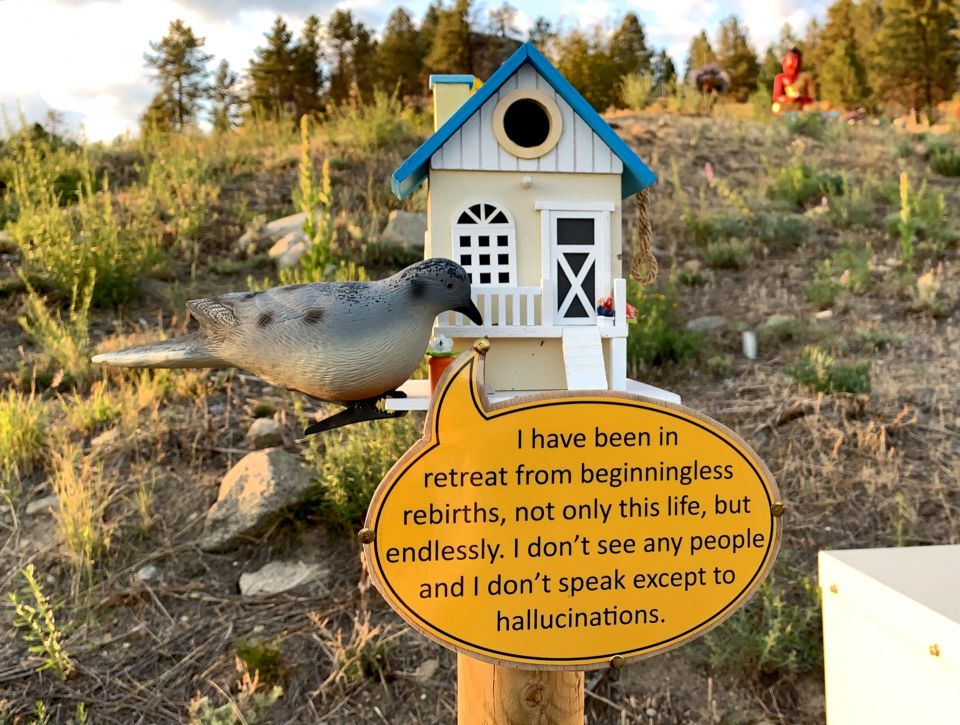
A display created by Lama Zopa Rinpoche at Buddha Amitabha Pure Land, Washington, US, August 2019. Photo by Ven. Holly Ansett.
FPMT spiritual director Lama Zopa Rinpoche has done much to care for the animals at Buddha Amitabha Pure Land (BAPL), located in a remote area of Washington State, in the northwestern United States. One examples is creating a bird feeder where birds and other animals are blessed by mantras as they feed.

A chipmunk at Buddha Amitabha Pure Land, Washington, US, July 2019. Photo by Ven. Lobsang Sherab.
Rinpoche has had many displays of animals statues with signs created on the retreat land, offering visitors short Dharma teachings. He also has had made many signs with mantras and images of deities that purify just by seeing.
In addition, BAPL has a 13-foot (4-meter) tall statue of Amitabha Buddha, which was created in Vietnam of white marble, as well as a smaller statue of Medicine Buddha. The statues are surrounded by beautiful gardens and flower offerings. Rinpoche has organized a yearly festival to honor the Amitabha statue and the retreat land.
A new video shows many of these statues, signs, and activities on the retreat land and features Rinpoche’s chanting.
Watch a video of tour of Buddha Amitabha Pure Land:
https://youtu.be/n6f2vNdL5PA
See photos from Rinpoche’s visit to Buddha Amitabha Pure Land and Pamtingpa Center in Washington State, US:
https://fpmt.org/teachers/zopa/gallery/washington-us-july-august-2019/
In October, watch Lama Zopa Rinpoche’s teachings streamed live from Russia:
https://fpmt.org/media/streaming/lama-zopa-rinpoche-live/
Find video and audio recordings and transcripts of Rinpoche’s recent teachings at Amitabha Buddhist Centre in Singapore:
https://fpmt.org/media/streaming/teachings-of-lama-zopa-rinpoche/amitabha-buddhist-center-singapore-2019/
Lama Zopa Rinpoche is the spiritual director of the Foundation for the Preservation of Mahayana Tradition (FPMT), a Tibetan Buddhist organization dedicated to the transmission of the Mahayana Buddhist tradition and values worldwide through teaching, meditation and community service.
- Tagged: animal art, animals, buddha amitabha pure land, video, video short
7
Change Your View of Others So They Can Also Change
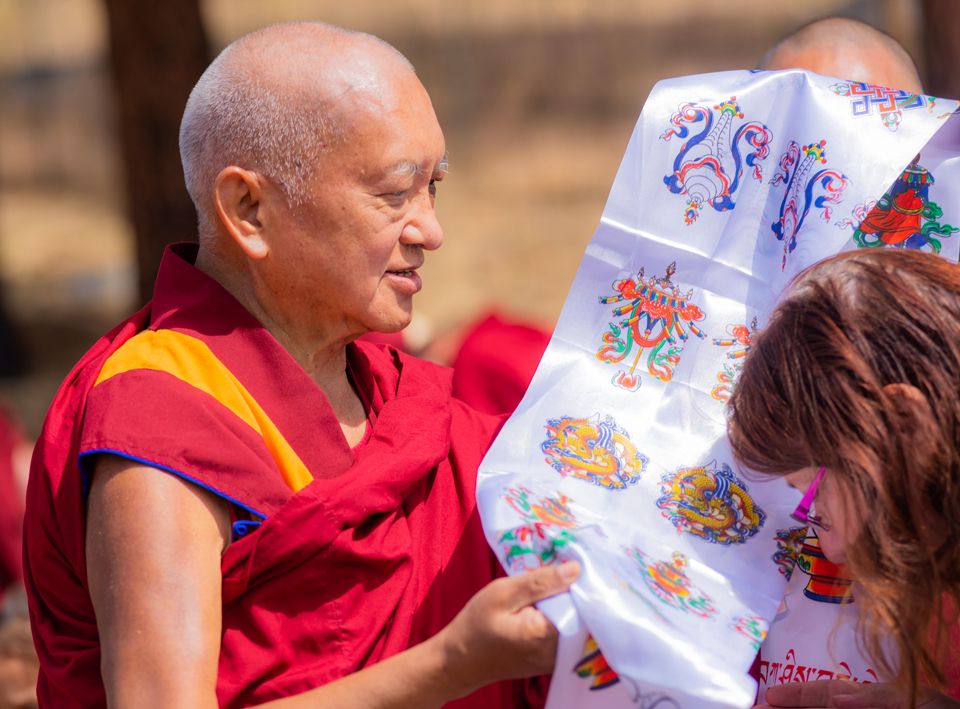
Lama Zopa Rinpoche at Amitabha Buddha Festival, Buddha Amitabha Pure Land, Washington State, US, August 2019. Photo by Chris Majors.
In a phone conversation with a student, Lama Zopa Rinpoche made these comments on how to resolve conflicts with other disciples of one’s guru, giving this advice for ridding oneself of past and present grudges by changing one’s own mind.
I have been wanting to tell you this for some time. There may have been something between you and that person before, some time ago, but now I want you to change your view of her and become harmonious with her. Change your view from your old way of looking at her and instead look at her with an open heart, seeing her as one of the pores of the guru.
The expression “pore of the guru” refers to the way in which one should regard anyone related to the guru, that is, as an integral part that is indivisible from the guru, to which consequently one should pay the same respect as to the very guru. If you do that, then she will change her way of looking at you. She won’t see you in the old way any more either, and the problem will go away.
Then, in the future, when there are differences of opinion, of course it is OK to present your ideas to her so that she has many ways of looking at things. But do so with an open heart and with love, concern, and a wish to help, without getting upset. Always view her with an open heart, as one of the pores of the guru. Then there won’t be any problems.
It’s the same with people you may be upset with now. Remember they have been very kind to you in the past. They have helped you a lot. Because of them, you have been able to experience and finish up so much of your own negative karma from the past.
Therefore, you should view them as one of the pores, and with an open heart, apologize for any difficulties in the past and thank them for all their kindness to you. This way, when you change your view of others, they can also change.
This advice “Conflicts with Fellow Students” was originally published in “Lama Zopa Rinpoche’s Online Advice Book” on the Lama Yeshe Wisdom Archive website:
https://www.lamayeshe.com/advice/conflicts-fellow-students
Watch Lama Zopa Rinpoche’s teachings streaming live from Russia:
https://fpmt.org/media/streaming/lama-zopa-rinpoche-live/
Find video and audio recordings and transcripts of Rinpoche’s recent teachings at Amitabha Buddhist Centre in Singapore:
https://fpmt.org/media/streaming/teachings-of-lama-zopa-rinpoche/amitabha-buddhist-center-singapore-2019/
Lama Zopa Rinpoche is the spiritual director of the Foundation for the Preservation of Mahayana Tradition (FPMT), a Tibetan Buddhist organization dedicated to the transmission of the Mahayana Buddhist tradition and values worldwide through teaching, meditation and community service.
- Tagged: harmony, lama zopa rinpoche
4
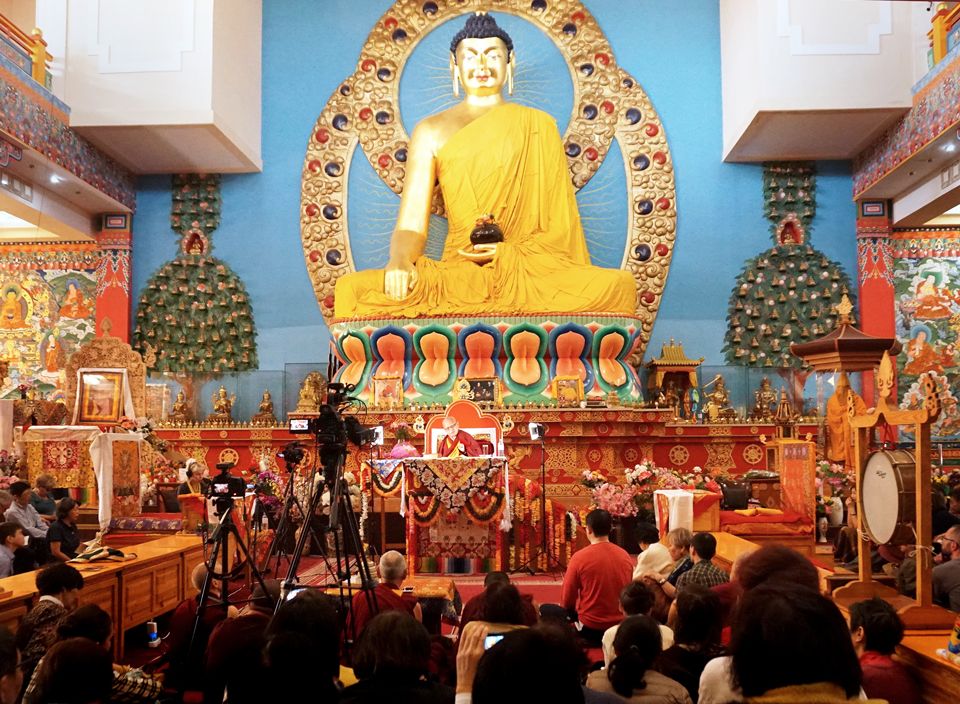
Lama Zopa Rinpoche teaching inside the temple called the Golden Abode of Shakyamuni Buddha, Elista, Kalmykia, Russia, May 2017. Photo by Ven. Lobsang Sherab.
On September 30, Lama Zopa Rinpoche arrived in Elista, the capital city of the Russian Republic of Kalmykia, which is the only region in Europe where Buddhism is the primary religion. Rinpoche traveled to Elista to offer a Great Chenrezig initiation and lead a 100 million mani retreat.
The events with Rinpoche begin on Friday, October 4, and run through October 20. Between 250-450 students are expected to attend, including many students from Ganden Tendar Ling, the FPMT center in Moscow.
Rinpoche then travels to Moscow to teach on “How to Develop Bodhicitta in the Modern World (a commentary on Khunu Lama Rinpoche’s The Jewel Lamp: A Praise of Bodhichitta),” October 25-27. Students from Ganden Tendar Ling are organizing the teachings in Moscow and also helping with the 100 million mani retreat in Elista.
Rinpoche’s teachings will be streamed live from Russia. For links to streaming video:
https://fpmt.org/media/streaming/lama-zopa-rinpoche-live/

The Golden Abode of Shakyamuni Buddha, Elista, Kalmykia, Russia, May 2019. Photo by Ven. Lobsang Sherab.
Learn More about Ganden Tendar Ling Center:
https://fpmt.ru/
Find video and audio recordings and transcripts of Rinpoche’s recent teachings at Amitabha Buddhist Centre in Singapore:
https://fpmt.org/media/streaming/teachings-of-lama-zopa-rinpoche/amitabha-buddhist-center-singapore-2019/
Lama Zopa Rinpoche is the spiritual director of the Foundation for the Preservation of Mahayana Tradition (FPMT), a Tibetan Buddhist organization dedicated to the transmission of the Mahayana Buddhist tradition and values worldwide through teaching, meditation and community service.
30

Lama Zopa Rinpoche being offered a khata by Khen Rinpoche Geshe Chonyi, Amitabha Buddhist Centre, Singapore, September 2019. Photo by Ven. Lobsang Sherab.
Lama Zopa Rinpoche concluded a busy visit to Singapore last week. Three weeks earlier, Rinpoche landed in Singapore, where he was enthusiastically greeted by students at the airport, despite the late time of his arrival.
During his visit at Amitabha Buddhist Centre (ABC), the FPMT center in Singapore, Rinpoche gave general teachings as well as commentary on Lama Chopa.
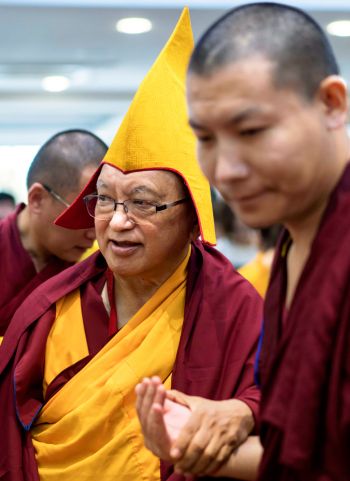
Lama Zopa Rinpoche at Amitabha Buddhist Centre, Singapore, September 2019. Photo by Ven. Lobsang Sherab.
Students at ABC offered a long life puja to Rinpoche with Lama Chopa and the Sixteen Arhat Long Life Prayers on Sunday, September 22.
Many students around the world watched the live webstreaming of Rinpoche’s teachings from ABC, especially in Taiwan, due to Ven. Thubten Dechen’s simultaneous translation of the teachings into Chinese.
Rinpoche’s teachings from ABC are available as video and audio recordings, including Italian translations of the teachings and a Spanish translation of one day of teachings. A written English transcript is also being made available.
ABC is a vibrant and active center. According to Ven. Holly Ansett, it’s a very inspiring center for its high level of student involvement and the scale of offerings and holy objects there. While staying at ABC, Rinpoche also attended the center’s 30th anniversary celebration.
Watch the Long Life Puja for Lama Zopa Rinpoche with Lama Chopa and Sixteen Arhat Prayers from ABC:
https://www.youtube.com/watch?v=bn3tyEXX43I
Learn more about Amitabha Buddhist Centre:
http://www.fpmtabc.org/
Find video and audio recordings and transcripts of Rinpoche’s recent teachings at Amitabha Buddhist Centre in Singapore:
https://fpmt.org/media/streaming/teachings-of-lama-zopa-rinpoche/amitabha-buddhist-center-singapore-2019/
Lama Zopa Rinpoche is the spiritual director of the Foundation for the Preservation of Mahayana Tradition (FPMT), a Tibetan Buddhist organization dedicated to the transmission of the Mahayana Buddhist tradition and values worldwide through teaching, meditation and community service.
27
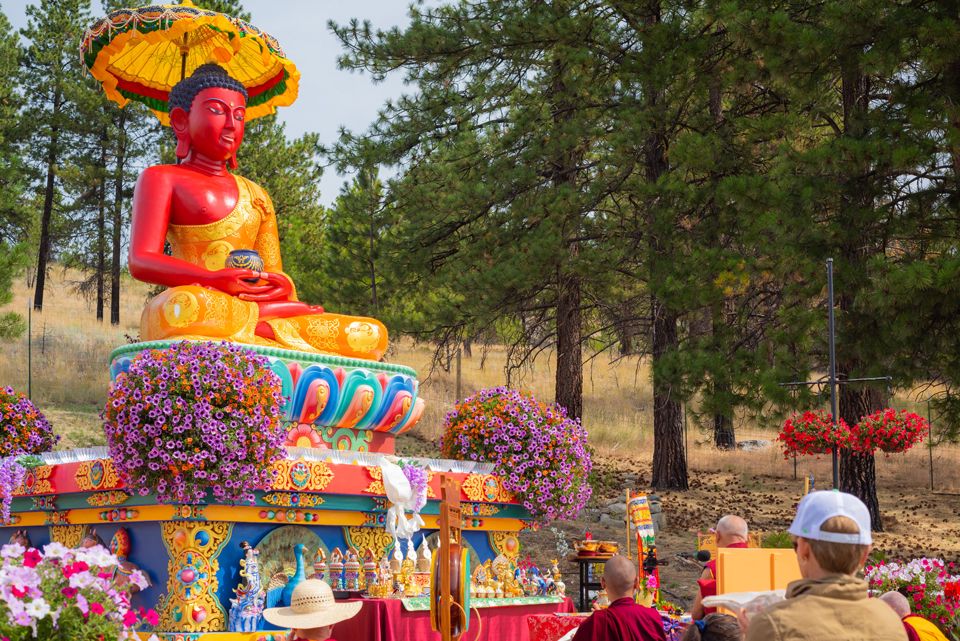
Amitabha Buddha Festival at Buddha Amitabha Pure Land, Washington, US, August 2019. Photo by Chris Majors.
In August, Lama Zopa Rinpoche attended the Amitabha Buddha Festival at Buddha Amitabha Pure Land (BAPL) in remote Washington State in the United States. This is the fourth time the festival has been held and the third time Rinpoche has attended. The festival was envisioned by Lama Zopa Rinpoche to honor the large Amitabha Buddha statue and retreat land at BAPL.
Rinpoche translated and created the text for the festival, which took place in front of the 13-foot (4-meter) tall Amitabha Buddha statue. Preparations for the festival took about a week and were done by the resident Sangha and the Sangha traveling with Rinpoche. Local students from the nearby Pamtingpa Center in Tonasket came for the festival.
Rinpoche, Sangha, and students did the offering prayers all morning. About forty to fifty people attended.
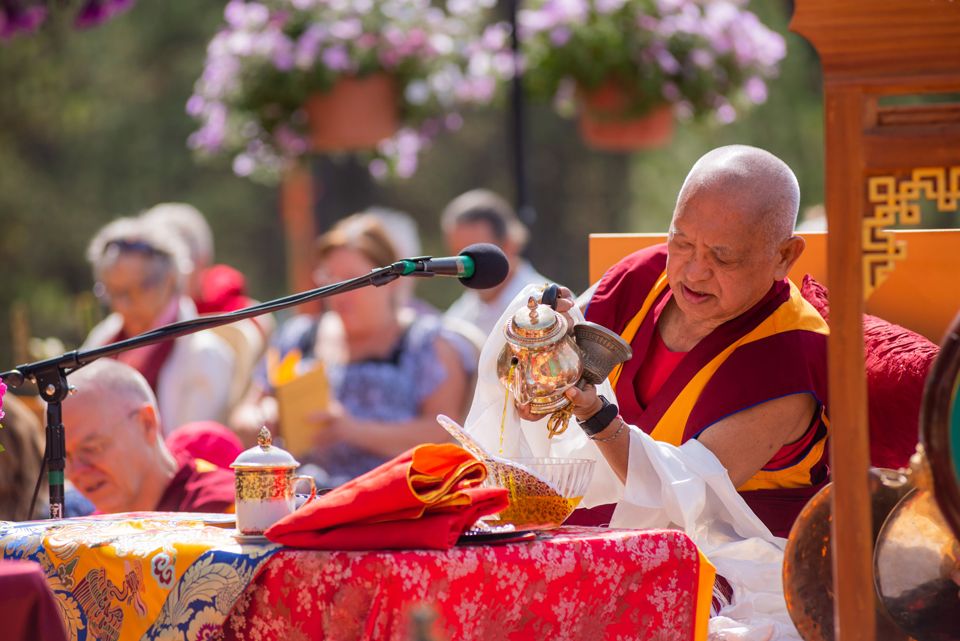
Lama Zopa Rinpoche at Amitabha Buddha Festival at Buddha Amitabha Pure Land, Washington, US, August 2019. Photo by Chris Majors.
Neighbors of the retreat land were invited for the offered lunch with Rinpoche, Sangha, and local students. About fifteen neighbors attended and enjoyed the event. People in the area tend to be conservative, so creating a good connection with them is important. Rinpoche was pleased with the event and said he thought it was very nice.
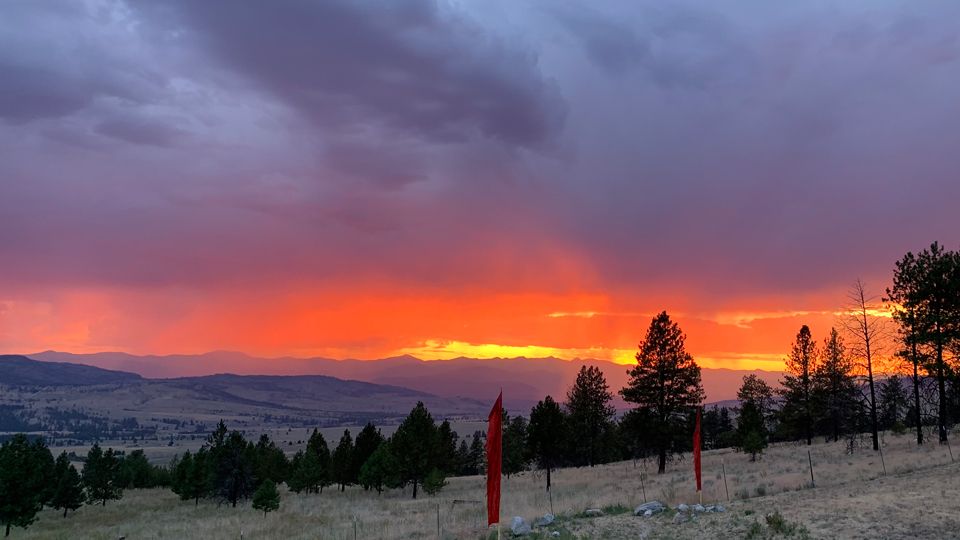
Sunset at Buddha Amitabha Pure Land, Washington, US, August 2019. Photo by Ven. Holly Ansett.

Lama Zopa Rinpoche blessing all the beings in Palmer Lake in Washington State, US, August 2019. Photo by Ven. Holly Ansett.
While staying at BAPL, Rinpoche also took time to bless a local lake. Rinpoche, Sangha, and students spent two days preparing blessed food for the fish in the lake. Then the group took two small boats on to the water.
Rinpoche’s boat had flags on it that he designed. The flags say, “Wish granting boat—fufilling all the wishes of the fish and all others who live in or use this water,” and “We are liberating the fish from the cause of suffering and bringing them to peerless happiness—the total cessation of all the obscurations and completion of all the realizations.”
Rinpoche recited sutras and mantras. The fish and other beings in the water were also blessed with a relic and a mantra blessing wheel, and were offered blessed food and water.
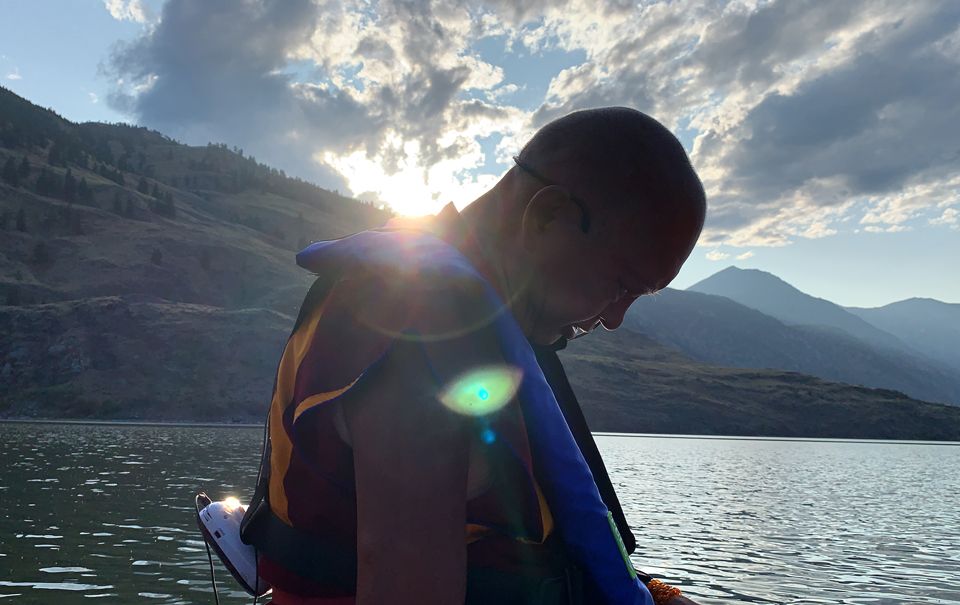
Lama Zopa Rinpoche on Palmer Lake in Washington State, US, August 2019. Photo by Ven. Holly Ansett.
See more photos from Rinpoche’s visit to Buddha Amitabha Pure Land and Pamtingpa Center in Washington State, US:
https://fpmt.org/teachers/zopa/gallery/washington-us-july-august-2019/
Find video and audio recordings and transcripts of Rinpoche’s recent teachings at Amitabha Buddhist Centre in Singapore:
https://fpmt.org/media/streaming/teachings-of-lama-zopa-rinpoche/amitabha-buddhist-center-singapore-2019/
Lama Zopa Rinpoche is the spiritual director of the Foundation for the Preservation of Mahayana Tradition (FPMT), a Tibetan Buddhist organization dedicated to the transmission of the Mahayana Buddhist tradition and values worldwide through teaching, meditation and community service.
- Tagged: amitabha buddha festival, animal art, animals, blessing water beings, buddha amitabha pure land, lama zopa rinpoche, pamtingpa center
2
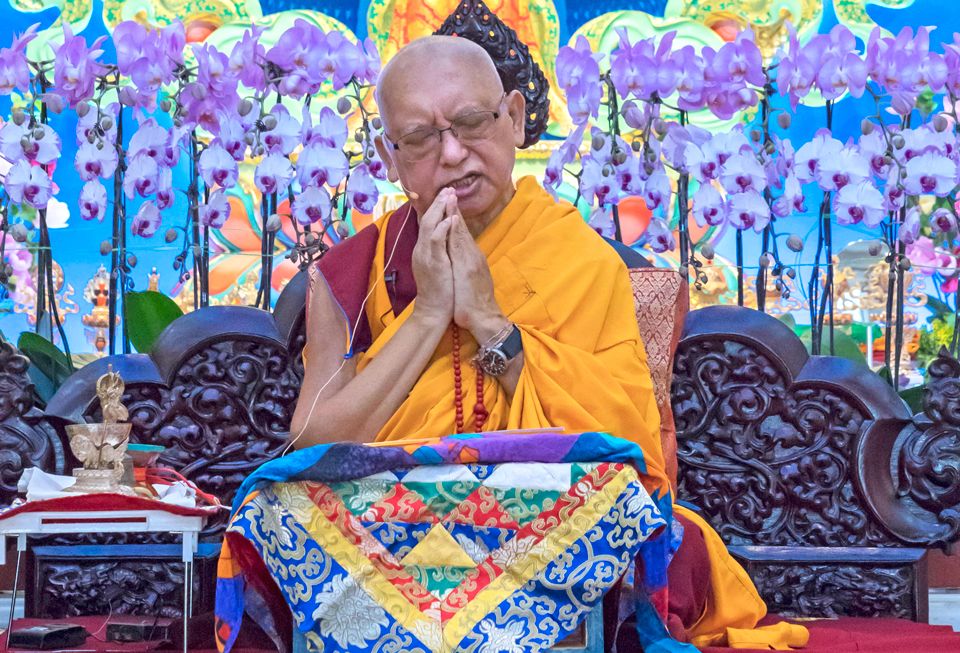
Lama Zopa Rinpoche teaching at Amitabha Buddhist Centre, Singapore, September 2018. Photo by Ven. Lobsang Sherab.
Lama Zopa Rinpoche continues his commentary on Lama Chopa (Guru Puja) practice at Amitabha Buddhist Centre, the FPMT center in Singapore.
Rinpoche’s teachings begin on Friday, September 6, and run through Saturday, September 21. All non-restricted teachings by Rinpoche will be webcast live.
The planned schedule of teachings at Amitabha Buddhist Centre in local time (GMT+8) is as follows:
- Friday, September 6, 7:30 p.m.–10 p.m.
- Saturday, September 7, 4 p.m.–6 p.m., 6:30 p.m.–8:30 p.m.
- Sunday, September 8, 4 p.m.–5:30 p.m.
- Wednesday, September 11, 7:30 p.m.–10 p.m.
- Friday, September 13, 7:30 p.m.–10 p.m.
- Saturday, September 14, 4 p.m.–6 p.m., 6:30 p.m.–8:30 p.m.
- Sunday, September 15, 4 p.m.–5:30 p.m.
- Wednesday, September 18, 7:30 p.m.–10 p.m.
- Saturday, September 21, 4 p.m.–6 p.m., 6:30 p.m.–8:30 p.m.
Following Rinpoche’s Lama Chopa commentary, Amitabha Buddhist Centre will be offering to Rinpoche the Sixteen Arhat Long Life Prayers on Sunday, September 22, 9:30 a.m.–12 p.m.
Useful links:
Watch Lama Zopa Rinpoche teach LIVE:
https://fpmt.org/media/streaming/lama-zopa-rinpoche-live/
Watch Lama Zopa Rinpoche’s 2018 commentary on Lama Chopa taught at Amitabha Buddhist Centre:
https://fpmt.org/media/streaming/teachings-of-lama-zopa-rinpoche/amitabha-buddhist-center-2018/
More information on the teaching event at Amitabha Buddhist Centre:
http://www.fpmtabc.org/2019/event/lzrvisit.php
Learn more about Lama Chopa practice and find FPMT Education Services materials:
https://fpmt.org/edu-news/it-is-all-there-in-lama-chopa/
Lama Zopa Rinpoche is the spiritual director of the Foundation for the Preservation of Mahayana Tradition (FPMT), a Tibetan Buddhist organization dedicated to the transmission of the Mahayana Buddhist tradition and values worldwide through teaching, meditation and community service.
30
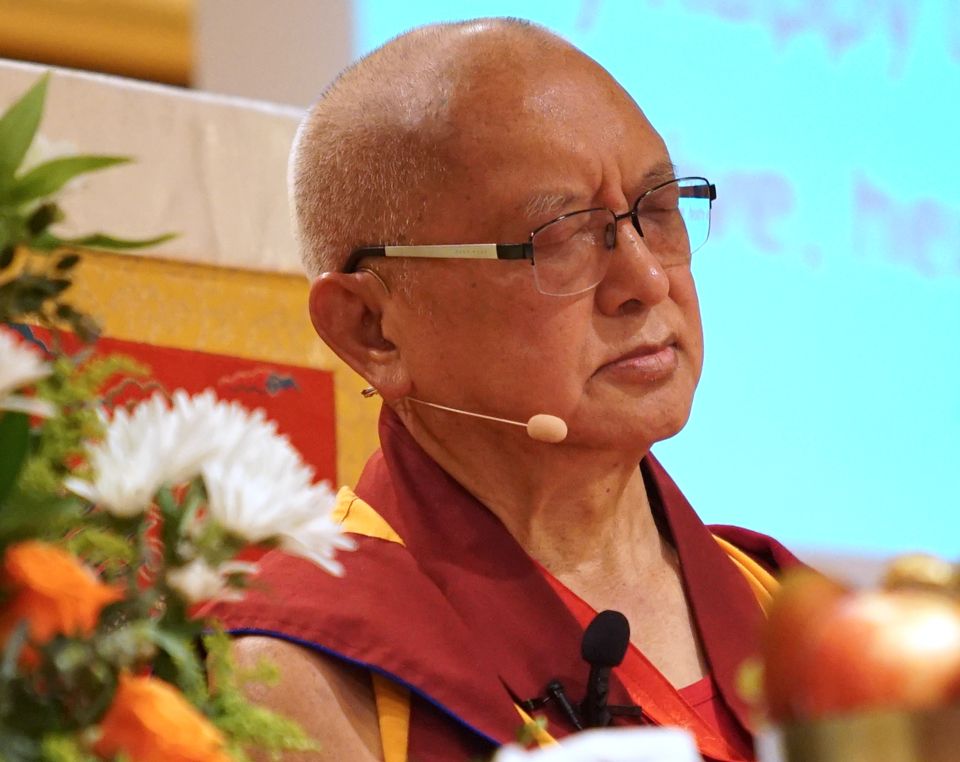
Lama Zopa Rinpoche teaching in Madrid, Spain, April 2019. Photo by Alexis Roitmann.
Lama Zopa Rinpoche offered advice to a studious former monk who wrote to Rinpoche about receiving criticism and abuse from people. Here’s an excerpt from Rinpoche’s advice:
Every day, in the morning, when you begin the day, please remember emptiness. Everything is empty: I, action, and object. You can recite the Heart Sutra and the quotations below.
If you can, remember them in your daily life again and again. When you open the door, when the day begins, while seeing the reality of phenomena or the reality of life, recite and meditate on the meaning of these words.
These are Buddha’s words from the Sutra of the King of Concentration:
As in the clear sky, the moon rises,
the reflection appears in the ocean,
but there is no transfer of the moon into the water:
All phenomena should be known to be of that nature.
The magician transforms the forms
Of various phenomena, like a horse carriage and an elephant,
but there is nothing there as it appears:
All phenomena should be known to be like that.
Exactly as when following sexual pleasure in a dream,
after the person wakes up, they cannot see it,
like an immature person who is extremely attached to sexual pleasures:
All phenomena should be known like that.
Exactly as in the dream of a young girl
Of giving birth to a son who died,
so happy to have given birth, but unhappy that he died:
All phenomena should be known like that.
Exactly like the nighttime moon
that appears in the water, calm and clear,
but the moon on the water is empty, you cannot catch it:
All phenomena should be known like that.
Exactly as at noon in autumn,
people tormented with thirst
see a mirage as water:
All phenomena should be known like this.
A mirage has no water.
Sentient beings are dying of thirst and desire to drink
but are unable to drink that water, which does not exist:
All phenomena should be known like that.
Exactly like the water tree:
even if a person wishes to take the essence from it,
a person splits that tree, there is no essence at all, no nectar inside or outside:
All phenomena should be known like that.
Also, it is good if you can recite the verses in the Thirty-Seven Practices of the Bodhisattva on emptiness, by the bodhisattva Thogme Zangpo.
Various sufferings appear in hallucinations, like a son who dies in a dream:
by holding it to be true, one suffers.
Therefore, when you encounter disharmonious conditions (that is, conditions not according to your wish, unfavorable conditions)
Looking at them as an illusion is the practice of the son of the bodhisattvas.
You are a very philosophical person. I am sure I don’t need to explain this to you. I am sure your mind is always this way, but I will explain it anyway.
The way to meditate on the first stanza is this: The meaning is that ignorance leaves imprints that are impure on the mental continuum. Like the moon reflecting on the ocean, those imprints project hallucinated appearances, truly existent appearances. They project all the hallucinations that appear, appearing as truly existent, on the merely labeled phenomena—I, action, object, happiness, suffering, virtue, non-virtue—whatever exists.
Including the mind as well as its object—the perceiver/knower, or mind, and its object—these look or appear like they are there, but they are not there. A truly existent real knower or perceiver, the mind and object, look like they are there, but they are not there.
In reality, everything is empty. Therefore, in reality all that is appearing as real is appearances, but is totally non-existent, empty.
All that appears to be real, inherently existent, in our daily life, this inherently existent phenomenon or real phenomenon, is totally non-existent. The way phenomena appear should be understood as non-existent, totally non-existent.
Therefore, all phenomena—I, action, object—all the phenomena that exist, are empty. They are empty from their own side. They are empty from their own side because all these phenomena exist by being merely labeled.
For the rest of the stanzas, you can get the basic idea from this explanation. Then all day you can laugh about your own life, your own beliefs, own fears, and grasping. You can laugh even when you are alone in your room. You can laugh twenty-four hours a day about your own life. You can laugh in the kitchen making tea. You can laugh in the shop. You can laugh in your bedroom, when you’re asleep, everywhere. You can laugh when you feel depressed. You can laugh when you feel excited.
The second part is thought transformation, how to meditate on emptiness during the meditation break and to look at all phenomena during break times like a dream. That means looking at the object of the knower as empty—not true: empty. Examining the nature of unborn wisdom—that is wisdom meditating on the emptiness of that—free even of the remedy itself.
Even the remedy, even emptiness itself, has no inherent existence, it is free of that. Look at emptiness itself as empty of inherent existence. This could also be related to the self, the person, the meditator, to oneself, as also empty.
Place the mind in the state of the base, which is the essence of the path. In the break time, be the illusory person. …
This advice “How to Use Criticism and Unfavorable Situations on the Path” was originally published in “Lama Zopa Rinpoche’s Online Advice Book” on the Lama Yeshe Wisdom Archive website:
https://www.lamayeshe.com/advice/how-use-criticism-and-unfavorable-situations-path
Watch short video of Lama Zopa Rinpoche teaching:
https://fpmt.org/media/streaming/videos-of-lama-zopa-rinpoche/
Lama Zopa Rinpoche is the spiritual director of the Foundation for the Preservation of Mahayana Tradition (FPMT), a Tibetan Buddhist organization dedicated to the transmission of the Mahayana Buddhist tradition and values worldwide through teaching, meditation and community service.
- Tagged: emptiness, lama zopa rinpoche
26
Renounce the Ego
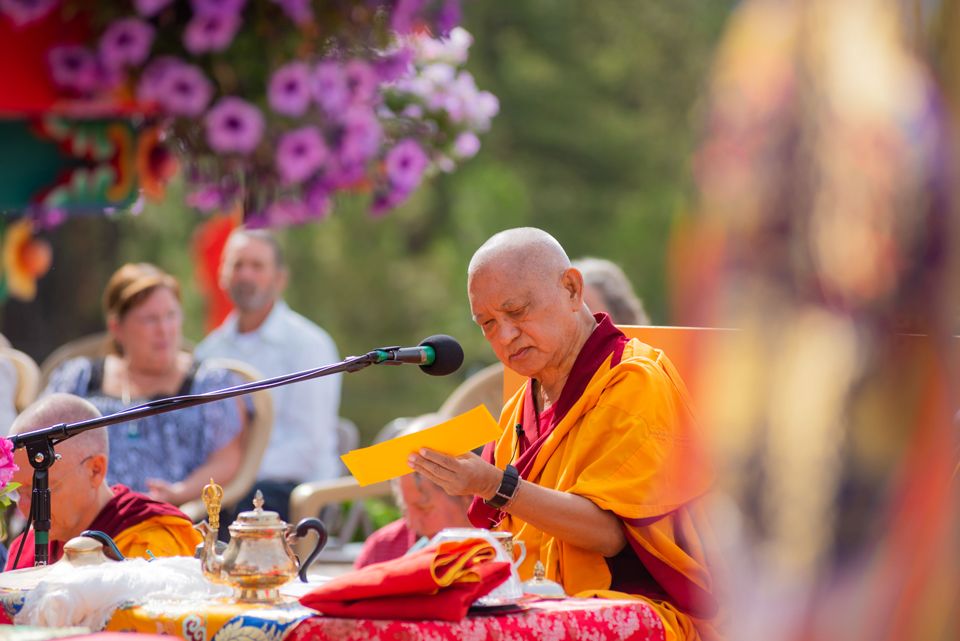
Lama Zopa Rinpoche at the Amitabha Buddha festival at Buddha Amitabha Pure Land, Washington, US, August 2019. Photo by Chris Majors.
Lama Zopa Rinpoche gave the following advice on the shortcomings of the self-cherishing thought and the benefits of cherishing others to a student and said it is applicable to anyone.
If you are my student, then you must do the morning motivation, The Method to Transform a Suffering Life into Happiness (Including Enlightenment). Do not just read the words, but relate them to your life. You must recite these words and if after reciting the words your mind doesn’t change, then you are not doing it [correctly].
In addition, I want you to recite these two verses as a dedication and to memorize them:
Whenever someone has an angry or devotional thought arise
Just by looking at me,
May that attitude alone become a cause that always
Accomplishes all the temporary and ultimate purposes of that being.
Whenever others criticize me with their speech,
Harm me with their bodies,
Or likewise insult me behind my back,
May all of them be fortunate to achieve great enlightenment.
You must recite these two verses and if these don’t change your mind, then you are not thinking about the meaning. Therefore, use these two verses often as your dedication. This is most important to recite; it’s good to recite and to remember by heart.
You need to remember that you yourself have harmed numberless sentient beings from beginningless rebirths numberless times. You have given every kind of harm numberless times to the numberless sentient beings. Now what you experience—the way others harm you, the way they treat you, anything unpleasant—is the result of your negative karma. So you have to recognize the shortcomings of your self-cherishing thought.
As the Kadampa geshe says:
Put all the blame to one. Toward others, meditate on their kindness.
Put all the blame to one—this is the self-cherishing thought. Even if someone sees you and dislikes you, thinks you are bad, or if anyone criticizes you or kicks you out of a center and so on, think it is the result of past karma, because you harmed others, numberless sentient beings, numberless times from beginningless rebirth.
Anything unpleasant you receive back is the result of your bad karma, your self-cherishing thought. This is what is to be abandoned in order to actualize bodhicitta.
In my morning motivation, it mentions, May I be used by sentient beings. This means you dedicate yourself to be the servant of sentient beings, to be totally used by sentient beings. This is what makes you achieve enlightenment as quickly as possible. Otherwise if you have too much ego, then you go to hell. If that is what you want, if you want that, then it is a totally different situation; if you would like to go to hell. But if you don’t like to go to hell, then you need to change the mind, to renounce the ego.
As the Kadampa Geshe mentions, the self-cherishing thought is something to be thrown away—a long distance—immediately. But others are to be taken into your heart and cherished immediately.
With much love and prayers…
This advice “Renounce the Ego” was originally published in “Lama Zopa Rinpoche’s Online Advice Book” on the Lama Yeshe Wisdom Archive website:
https://www.lamayeshe.com/advice/renounce-ego
Find links to the free practice booklet The Method to Transform a Suffering Life into Happiness (Including Enlightenment) with Additional Practices in multiple languages and to Lama Zopa Rinpoche’s commentary on it on FPMT Education Services “Prayers & Practices” page:
https://fpmt.org/education/prayers-and-practice-materials/#themethod
Lama Zopa Rinpoche is the spiritual director of the Foundation for the Preservation of Mahayana Tradition (FPMT), a Tibetan Buddhist organization dedicated to the transmission of the Mahayana Buddhist tradition and values worldwide through teaching, meditation and community service.
23
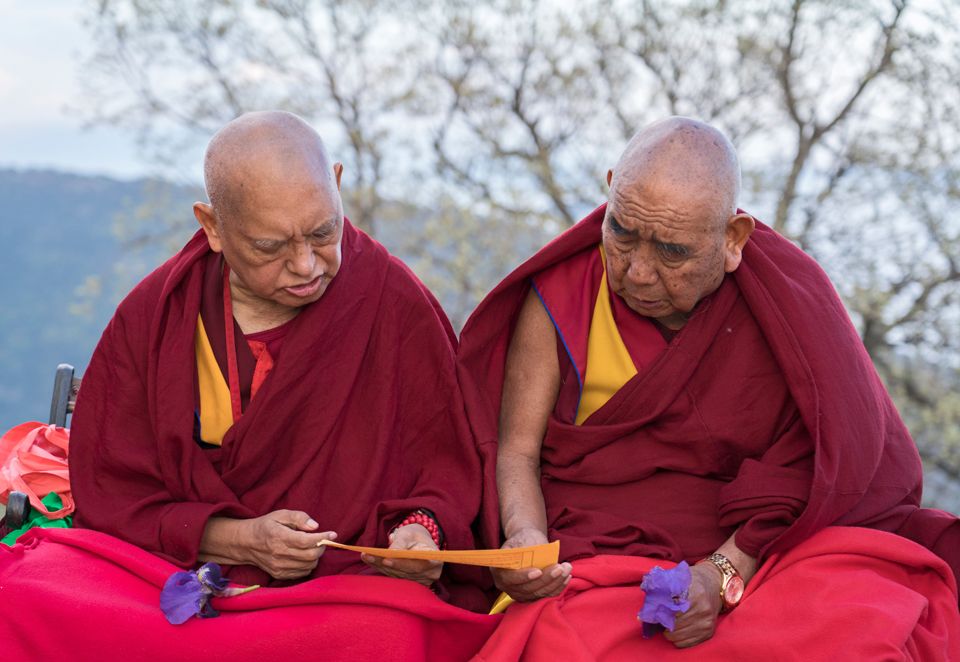
Lama Zopa Rinpoche and Geshe Lamsang at O.Sel.Ling Centro de Retiros, Spain, May 2019. Photo by Ven. Lobsang Sherab.
Lama Zopa Rinpoche offered the following advice “Problems at a Dharma Center” to the director of a Dharma center who was having problems with his assistant and thinking about asking the assistant to leave. Here’s an excerpt from that advice:
One way you can look at the situation is to think that the center just cannot exist without these difficulties. There is collective karma, and without these difficulties, it would not be able to offer extensive benefits to so many sentient beings every year, giving Dharma education in sutra and tantra, and planting the seed of the four kayas, liberation, and enlightenment, and leading sentient beings to a good rebirth in their next life.
The center offers unbelievable benefits. The geshe, translator, director, assistant, secretary, bookkeeper, cook, and cleaner’s main function is to bring the teachings to others, making the center available for sentient beings to come there to practice, collect merit, and plant the seed of enlightenment. All the members of the center are offering this benefit to sentient beings. This cannot happen without collective karma. Problems occur because collective negative karma ripens and individual karma ripens, so we experience these things while we are offering extensive benefit to others.
You can make an analogy with the body and ornaments on the body. These difficulties are the ornaments. This means you can use these difficulties to overcome your own delusions, ego, and self-cherishing thought. These difficulties destroy one’s delusions and ego, like in chöd practice. In chöd, you invoke spirits to create violence, a disturbing violent environment, and that makes the thought of self-cherishing stronger, the feeling that something is going to happen to me, to the “I.” The main thing is to see the emotional “I,” the false “I,” the object to be refuted, the “I” which is a hallucination, the “I” which doesn’t exist, as the object of the root of samsara—the concept of inherent existence. The minute you recognize it is the minute to realize emptiness.
Why this is so important, such a big deal, and is talked about so much in the teachings of Buddha is that without this realization of emptiness, you have no way to escape the ocean of suffering. Humans, asura, sura, hell beings, animals, and pretas have all been reincarnating in these realms up to now, from beginningless time, because of delusion and karma. We are still wandering in the six realms, and suffer without end. That means we can’t liberate other sentient beings from the suffering of samsara, the suffering of contaminated aggregates.
All the problems of the center are the same as in chöd practice. Here, without your putting effort into it, it just happens, the disturbed violent environment arises. So, it is a very good opportunity to realize emptiness and destroy the ego, the self-cherishing thought.
It is the same as in the text The Wheel of Sharp Weapons, when you use difficulties to cut the demon of your self-cherishing thought. It is also mentioned in A Guide to the Bodhisattva Way of Life that when people have scars from having fought in a war, they see those scars not as something ugly, but as an ornament, a special sign that they have been brave. They are proud of those scars. So, like that, you can use the problems in the center as a challenge to vanquish the self-cherishing thought and ignorance, the concept of true existence, the unknowing mind. …
Read the complete advice “Problems at a Dharma Center” in “Lama Zopa Rinpoche’s Online Advice Book” on the Lama Yeshe Wisdom Archive website:
https://www.lamayeshe.com/advice/problems-dharma-center
Watch short video of Lama Zopa Rinpoche teaching:
https://fpmt.org/media/streaming/videos-of-lama-zopa-rinpoche/
Lama Zopa Rinpoche is the spiritual director of the Foundation for the Preservation of Mahayana Tradition (FPMT), a Tibetan Buddhist organization dedicated to the transmission of the Mahayana Buddhist tradition and values worldwide through teaching, meditation and community service.
- Tagged: center advice, center director, lama zopa rinpoche, problems
19
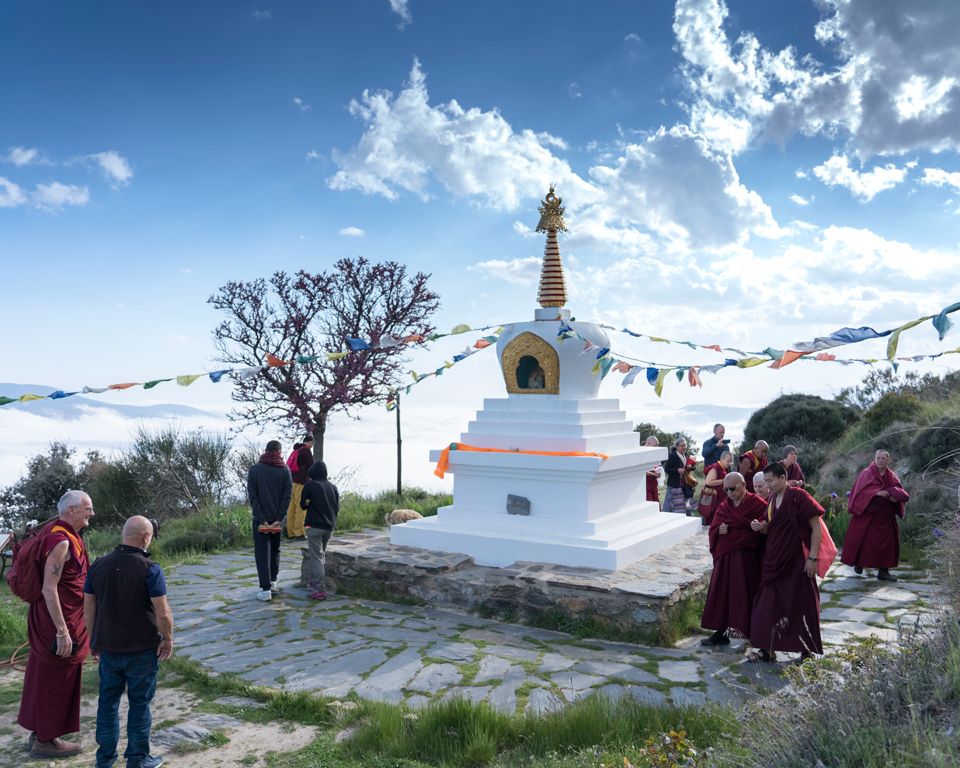
Lama Zopa Rinpoche circumambulating the stupa at O.Sel.Ling Centro de Retiros, Spain, May 2019. Photo by Ven. Lobsang Sherab.
Lama Zopa Rinpoche gave advice on how to utilize difficulties on the path to enlightenment to a student who had written to him about relationship problems.
All the problems are very good because they purify negative karma accumulated in the past. Those difficulties and problems in your life purify the very heavy negative karmas collected in many lifetimes in the past. By purifying that, you will experience much happiness in the future like the sun shining; therefore it’s positive.
Remember you have received many teachings for a long time and especially chöd practice. Chöd should not be just chanting, but the practice. It is especially for dealing with all these problems that you are experiencing, so you utilize the difficulties as the quickest way to achieve enlightenment for yourself and to free the numberless sentient beings from oceans of samsaric suffering and bring them to peerless happiness, the state of omniscience.
Lama Chopa [v. 103]:
Should even all the beings of the three realms without exception
Become angry at me, humiliate, criticize, threaten, or even kill me,
I seek your blessings not to be agitated, but to complete the perfection of patience
That works for their benefit in response to their harm.
The essence is explained in Lama Chopa [v. 96]:
Even if the environment and beings are filled with the fruits of negativity,
And unwished for sufferings pour down like rain,
I seek your blessings to take these miserable conditions as a path
By seeing them as causes to exhaust the results of my negative karma.
Please take time to think about the meaning of these verses.
This advice “How Problems Purify Past Negative Karma” was originally published in “Lama Zopa Rinpoche’s Online Advice Book” on the Lama Yeshe Wisdom Archive website:
https://www.lamayeshe.com/advice/how-problems-purify-past-negative-karma
Find complete videos of Lama Zopa Rinpoche’s recent teachings:
https://fpmt.org/media/streaming/teachings-of-lama-zopa-rinpoche/
Lama Zopa Rinpoche is the spiritual director of the Foundation for the Preservation of Mahayana Tradition (FPMT), a Tibetan Buddhist organization dedicated to the transmission of the Mahayana Buddhist tradition and values worldwide through teaching, meditation and community service.
- Tagged: karma, lama zopa rinpoche, problems, purification
12
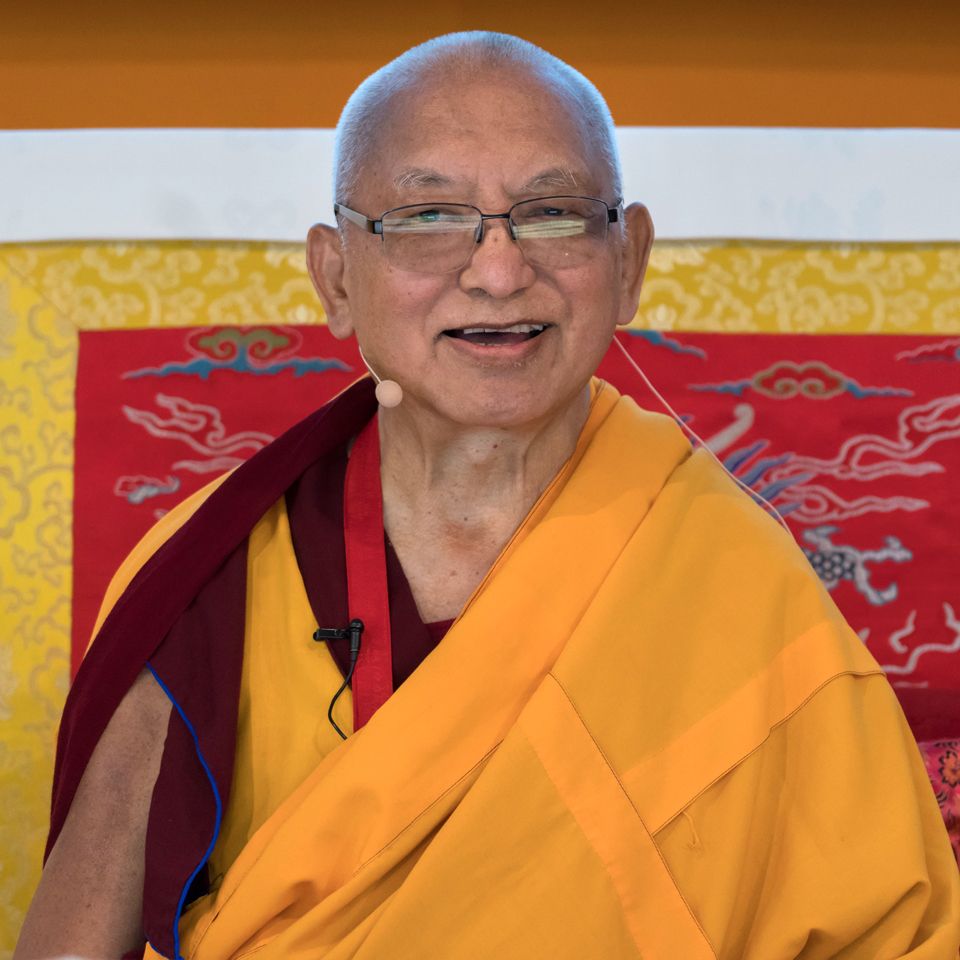
Lama Zopa Rinpoche teaching at Institut Vajra Yogini, France, May 2019. Photo by Ven. Lobsang Sherab.
Lama Zopa Rinpoche sent the following advice to three students who had written him complaining about a center director.
… Yes, I have also heard complaints from the director as well as from you. The reality is that there is negativity on both sides. I am not saying one is completely pure and the other is bad, unless one is Buddha. Then, that is my own problem.
Again, to remind you, if we accept karma, first there is whatever we experience with our senses. Whatever appearances we experience are the result of past good and bad karma. Have you heard of one liquid appearing differently to a preta being, a hell being, a god being, and Buddha? The solution is, if we want to enjoy nectar, we have to purify the negative karma of seeing pus.
In the letter, you never talk about your own negative karma and wrong conceptions. In the letter it always sounds like one is perfect and the other is always wrong. The letter never talks about your own mistakes, only others’ mistakes. This is my general view of how I see your letter.
If you sincerely care about the organization of the center and the FPMT, then I appreciate that very much. One reason why people criticize the center is because you criticize it to the world, so when people hear about the center, they also start criticizing. They are just like children believing bad things from the television. …
Previously at another center, everybody complained about the director. We made one of the people who’d complained the new director, and then everyone complained about the new director.
Much love and prayer…
This advice was originally published in 2011 as “Complaints about Director” in “Lama Zopa Rinpoche’s Online Advice Book” on the Lama Yeshe Wisdom Archive website:
https://www.lamayeshe.com/advice/complaints-about-director
Watch short video of Lama Zopa Rinpoche teaching:
https://fpmt.org/media/streaming/videos-of-lama-zopa-rinpoche/
Lama Zopa Rinpoche is the spiritual director of the Foundation for the Preservation of Mahayana Tradition (FPMT), a Tibetan Buddhist organization dedicated to the transmission of the Mahayana Buddhist tradition and values worldwide through teaching, meditation and community service.
9
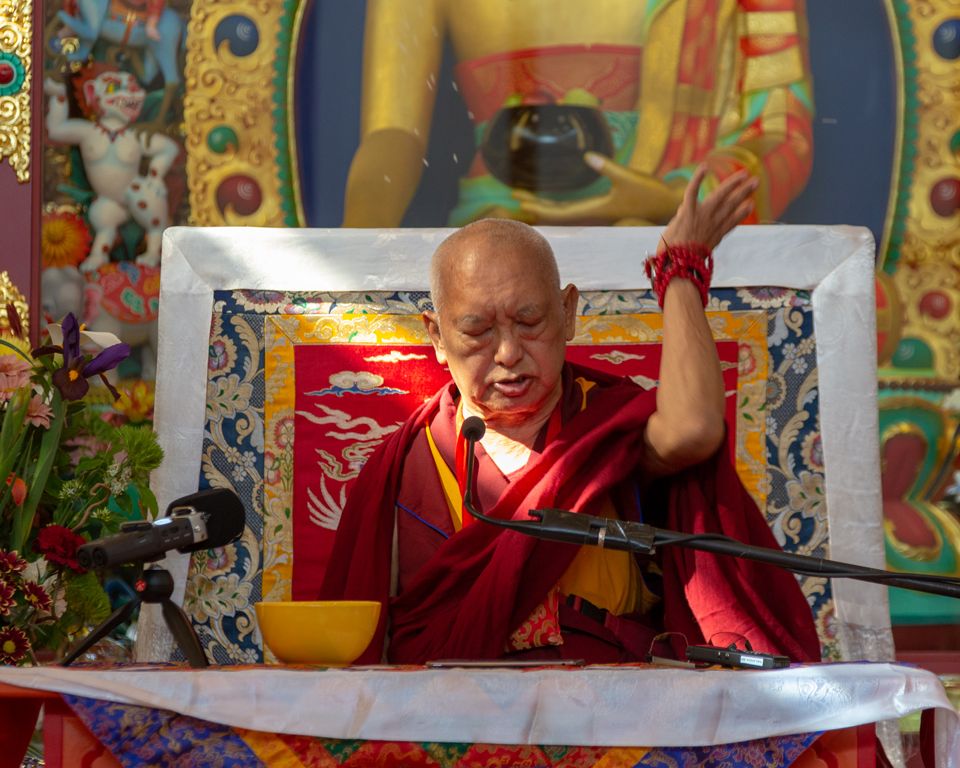
Lama Zopa Rinpoche at Nalanda Monastery, Labastide St. Georges, France, May 2019. Photo by Nicolas Balthazar.
Lama Zopa Rinpoche dictated this advice during a Light of the Path retreat and had it distributed to the retreat participants. Rinpoche then also wanted it shared with people offering service at FPMT centers, projects, and service as well as with all beings everywhere.
How to Make Your Life Most Beneficial for Sentient Beings, Even with Your Speech
Freeing them from the oceans of samsaric suffering and bringing them to the peerless happiness of buddhahood—the total cessation of all obscurations and the completion of all realizations
It all depends on your motivation. If you are motivated by the self-cherishing thought, concern for only your own happiness, your own power, and have no concern for others’ happiness, your motivation is coming from your delusions, such as attachment, anger, ignorance, and so forth. Then your actions of body, speech, and mind will manifest as ugly, unpeaceful, and hurtful to others and, as a result, others will react in an ugly, unpeaceful, and hurtful way with their body, speech, and mind; for example, by getting angry at you. It is like a circle. How you treat others and how they treat you in return is similar, with such negative thoughts and actions. You have to be fully aware of that in your everyday life.
Generally you have to know that you are responsible to not cause others suffering but to bring them happiness. Even if you don’t think of practicing Dharma, to at least be a good human being you need to know this. You are totally responsible as to whether you bring happiness or suffering to others. It is totally dependent on your motivation and how you treat others; it’s up to you whether your motivation is pure or not. Even just to be a good person, a generous human being, you have to know that. If you have a bad motivation and your actions of body, speech, and mind are harmful for others, you make others create negative karma when they retaliate by harming you in return. By harming others you therefore cause them to be reborn in the lower realms; to lose their human rebirth and take a lower rebirth and suffer for eons. Can you imagine yourself being in the lower realms? That’s where you’re causing other sentient beings to go and have unhappiness instead of enjoyment.
In the Bodhicaryavatara, Shantideva said,
Smiling at others (showing them a pleasant face)
Causes you to have a beautiful body in future lives.
So you don’t need to have plastic surgery or other expensive procedures. Your positive mind can give you a pleasant, happy, smiling face and a peaceful, not a political, smile. Others will feel this and also become like that, having a good heart and being smiling and happy. Thus you always have to be aware of how others act toward you, positive or negative. It is totally dependent upon your own mind.
The morning motivation, the Method to Transform a Suffering Life into Happiness (Including Enlightenment), contains the details for keeping your mind positive. If you do this motivation every morning you will always act positively toward others for the rest of the day.
However, first think that all your past, present, and future happiness, including enlightenment, is received from every sentient being. You receive everything through the kindness of every sentient being, which includes even those people you don’t like—those who make you angry merely upon sight or when you hear their voice. It is so important to understand this evolution. Therefore you should hold all sentient beings in your heart and feel that they are most precious, most kind, most dear and wish fulfilling for you. Then there will be no way for your mind to get angry or to generate ignorance, attachment, selfishness, or self-cherishing, and therefore, no way for you to harm others. You absolutely dare not harm others, even in the slightest way.
Even Buddha, Dharma, and Sangha—in whom you always take refuge to be free from the lower realms and get higher rebirths; to be free from samsara and achieve liberation, lower nirvana; and to be free from the self-cherishing thought and achieve the peerless happiness of total cessation of all mistakes and completion of all realizations—even this Buddha, Dharma, Sangha in whom you take refuge and who give you all this happiness come from sentient beings, including the ones who are angry at or who harm you, who speak to you hurtfully, and so forth, sentient beings that you don’t like. Therefore they are all so precious, unbelievably precious to you. On top of that, they have been your kind mother from beginningless rebirths and even now; it’s unbelievable. So you have to think about this and the dependent arising I mentioned before as well. Think about these two things—it makes not harming and only benefiting others very deep. In that way your life will be only of benefit.
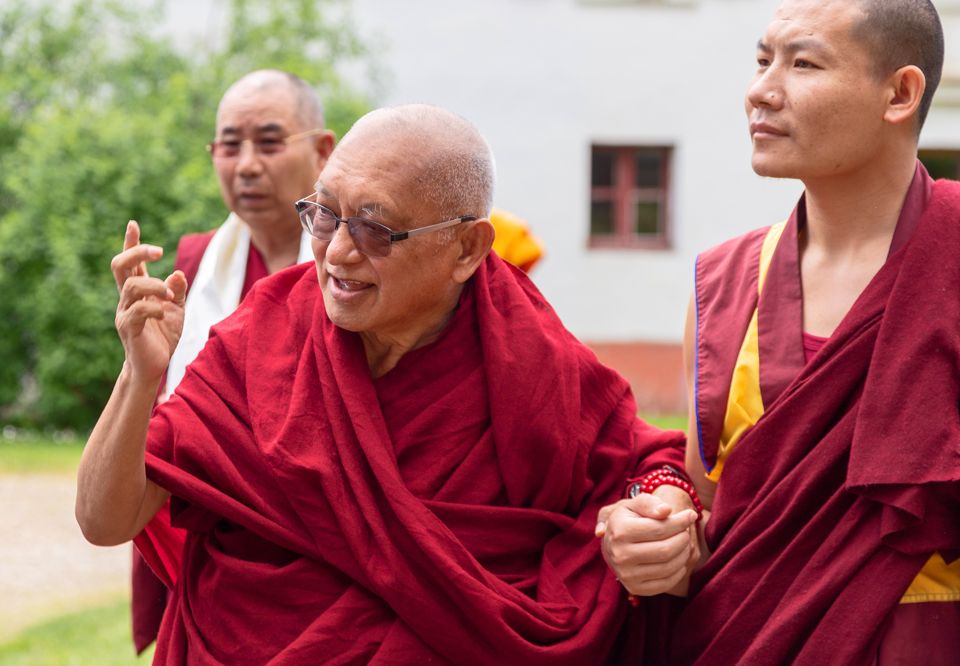
Lama Zopa Rinpoche arriving at Nalanda Monastery, Labastide St. Georges, France, May 2019. Photo by Nicolas Balthazar.
The conclusion is that to be free from the suffering of samsara as quickly as possible and to achieve peerless happiness, the total cessation of all mistakes and the completion of all realizations, then with this thought, smile at others, respect them with your body, speech, and mind, and speak to them in a nice, respectful way.
Treat people the way you’d like them to treat you: with respect, nice speech, and smiles that come from a good heart. If you do that, then, as a result of karma, many others will treat you in the same way. Otherwise others will be angry with you, speak to you rudely and hurtfully, and harm you with the actions of their body, speech, and mind.
So here I am mentioning how sentient beings are most kind, most precious, most dear and wish fulfilling. Then you can really enjoy life with them, bring them much inner happiness, and in your own mind you will also enjoy much inner happiness, and that will make them happy too.
His Holiness the Dalai Lama respects even ordinary people. He bends down in respect; Lama Yeshe also did this. Even when he heard about someone’s mistakes, some problems with monks, and so forth, when he later met them he showed respect. Like that, this is an incredible practice, rather than feeling pride, showing arrogance, and putting others down. Most people might do that, but in my experience, Lama Yeshe never did.
Behaving like this is a great, great, great responsibility of the center director, secretary, board members, office manager, treasurer, spiritual program coordinator, bookshop manager, and so forth. Especially these people, but in general, this is for everybody. It’s a question of karma, to not create negative karma and to create good karma. This not only makes you happy but also makes other sentient beings happy. So even with your speech you can make so many sentient beings happy. …
Read Lama Zopa Rinpoche’s complete advice “How to Make Your Life Most Beneficial for Sentient Beings, Even with Your Speech“:
Lama Zopa Rinpoche is the spiritual director of the Foundation for the Preservation of Mahayana Tradition (FPMT), a Tibetan Buddhist organization dedicated to the transmission of the Mahayana Buddhist tradition and values worldwide through teaching, meditation and community service.
- Home
- News/Media
- Study & Practice
- About FPMT Education Services
- Latest News
- Programs
- New to Buddhism?
- Buddhist Mind Science: Activating Your Potential
- Heart Advice for Death and Dying
- Discovering Buddhism
- Living in the Path
- Exploring Buddhism
- FPMT Basic Program
- FPMT Masters Program
- FPMT In-Depth Meditation Training
- Maitripa College
- Lotsawa Rinchen Zangpo Translator Program
- Universal Education for Compassion & Wisdom
- Online Learning Center
- Prayers & Practice Materials
- Overview of Prayers & Practices
- Full Catalogue of Prayers & Practice Materials
- Explore Popular Topics
- Benefiting Animals
- Chenrezig Resources
- Death & Dying Resources
- Lama Chopa (Guru Puja)
- Lama Zopa Rinpoche: Compendium of Precious Instructions
- Lama Zopa Rinpoche: Life Practice Advice
- Lama Zopa Rinpoche Practice Series
- Lamrim Resources
- Mantras
- Prayer Book Updates
- Purification Practices
- Sutras
- Thought Transformation (Lojong)
- Audio Materials
- Dharma Dates – Tibetan Calendar
- Translation Services
- Publishing Services
- Teachings and Advice
- Find Teachings and Advice
- Lama Zopa Rinpoche Advice Page
- Lama Zopa Rinpoche: Compendium of Precious Instructions
- Lama Zopa Rinpoche Video Teachings
- ༧སྐྱབས་རྗེ་བཟོད་པ་རིན་པོ་ཆེ་མཆོག་ནས་སྩལ་བའི་བཀའ་སློབ་བརྙན་འཕྲིན།
- Podcasts
- Lama Yeshe Wisdom Archive
- Buddhism FAQ
- Dharma for Young People
- Resources on Holy Objects
- Ways to Offer Support
- Centers
- Affiliates Area
- Teachers
- Projects
- Charitable Projects
- Make a Donation
- Applying for Grants
- News about Projects
- Other Projects within FPMT
- Support International Office
- Projects Photo Galleries
- Give Where Most Needed
- FPMT
- Shop
Translate*
*powered by Google TranslateTranslation of pages on fpmt.org is performed by Google Translate, a third party service which FPMT has no control over. The service provides automated computer translations that are only an approximation of the websites' original content. The translations should not be considered exact and only used as a rough guide.Anybody who dedicates their life to achieving lam rim realizations with the goal to liberate numberless beings from the oceans of samsaric suffering and to bring to enlightenment, this is what I regard as the most important thing in the world.







